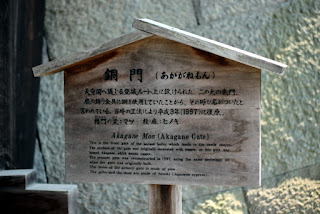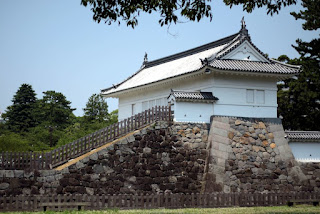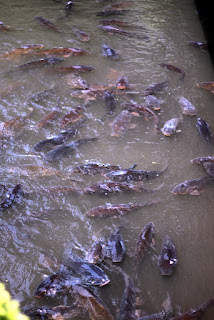Odawara Castle is one of Japan`s most underrated castles. Odawara Castle is an Edo Period castle from the Kamakura Era. Kobayakawa Tohira first build the Odawara castle. After that Hojo
So-un seized it from him in 1495. The Castle became the residence of a Mr. Okubo in the Edo Period,
and towered over the city as a symbol of Odawara until its destruction
in 1860. The outside of the present structure was restored and renovated in 1960 using
fortified concrete, and the inside is an exhibition room for ancient
books, paintings, amour, swords and other historical documents and
artifacts. Photography is prohibited inside the castle museum.
There is also a souvenir shop in the topfloor of the castle.
The height of the castle is 60m and people can get a panoramic view of Sagami Bay.
There is also a souvenir shop in the topfloor of the castle.
The height of the castle is 60m and people can get a panoramic view of Sagami Bay.
There are three gates to reach the main building, and the whole campus is protected by wall and waterbodies outside the wall.
How to Reach Odawara Castle:
The Odawara castle is located at 6-1 Jonai
Odawara, Kanagawa Prefecture 250-0014, Japan. The contact no. is +81 465-22-3818. Tourists can come here on their way to the hot spring at Hakone and spend the morning in the premises.
History of Odawara Castle:
Odawara was a stronghold of the Doi clan during the Kamakura period, and a fortified residence was built by their collateral branch, the Kobayakawa clan stood on the approximate site of the present castle. After the Uesugi Zenshu Revolt of 1416, Odawara came under the control of the Omori clan of Suruga, who were in turn defeated by Ise Moritoki of Izu, founder of the Late Hōjō clan in 1495. Five generations of the Late Hōjō clan improved and expanded on the fortifications of Odawara Castle as the center of their domains, which encompassed most of the Kantō region.
During the Muromachi period, Odawara Castle had very strong defenses, as it was situated on a hill, surrounded by moats with water on the low side, and dry ditches on the hill side, with banks, walls and cliffs located all around the castle, enabling the defenders to repel attacks by the great warriors Uesugi Kenshin in 1561 and Takeda Shingen in 1569. However, during the Battle of Odawara in 1590, Toyotomi Hideyoshi forced the surrender of the Late Hōjō clan through a combination of a three-month siege and bluff. After ordering most of the fortifications destroyed, he awarded the holdings of the Late Hōjō to Tokugawa Ieyasu.
After Ieyasu completed Edo Castle, he turned site of Odawara Castle over to one of his senior retainer, Ōkubo Tadayo, who reconstructed the castle in its present form on a considerably reduced scale, with the entire castle fitting inside what was the third bailey of the original Late Hōjō castle. Aside from an interruption from 1619–1685, during which time the Inaba clan extensively renovated the castle, the Ōkubo clan ruled over Odawara Domain from Odawara Castle until the Meiji Restoration.
Tokugawa Iemitsu, the 3rd Tokugawa Shōgun, visited Odawara Castle in 1634. The donjon built by the Inaba was destroyed in an earthquake in 1703, but was rebuilt by 1706. The new Meiji government ordered the destruction of all former feudal fortifications, and in compliance with this directive, all structures of Odawara Castle were pulled down from 1870–1872, with the stone base of the former donjon becoming the foundation for a Shinto shrine, the Ōkubo Jinja, dedicated to the spirits of the generations of Ōkubo daimyō. In 1909, the Odawara Imperial Villa was constructed within the site of the former inner and second bailies. The Imperial Villa was destroyed by the 1923 Great Kanto Earthquake. Repair work was made to the stone walls from 1930–1931, but with very poor workmanship. In 1935, two of the remaining yagura (which had been destroyed in the 1923 earthquake) were restored, but on a half-scale. In 1938, the castle site was proclaimed a national historic monument, with the area under historic preservation restrictions expanded in 1959, and again in 1976 based on further archaeological investigations.
In 1950, repairs were made to the stone base of the former donjon, which had been in ruins since the Great Kanto Earthquake, and the area was made into the Odawara Castle Park, which includes an art museum, local history museum, city library, amusement park and zoo. The three-tiered, five-storied donjon, the top floor of which is an observatory was rebuilt in 1960 out of reinforced concrete to celebrate the 20th anniversary of the proclamation of Odawara as a city. However, the reconstructed donjon is not historically accurate, as the observation deck was added at the insistence of the Odawara City tourism authorities. Plans have been discussed since the late 1960s on a more accurate restoration of the central castle grounds to its late Edo period format. These plans resulted in the reconstruction of the Tokiwagi Gate in 1971, the Akagane Gate in 1997, and the Umade Gate in 2009.
The reconstructed Odawara Castle was listed as one of the 100 Fine Castles of Japan (as chosen by the Japan Castle Foundation) in 2006.
The history of the castle was taken from Wikipedia.












No comments:
Post a Comment